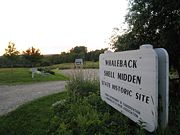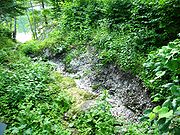
Whaleback Shell Midden
Encyclopedia


Midden
A midden, is an old dump for domestic waste which may consist of animal bone, human excrement, botanical material, vermin, shells, sherds, lithics , and other artifacts and ecofacts associated with past human occupation...
, or dump, consisting primarily of oyster
Oyster
The word oyster is used as a common name for a number of distinct groups of bivalve molluscs which live in marine or brackish habitats. The valves are highly calcified....
shells located on the east side of the Damariscotta River
Damariscotta River
The Damariscotta River is a tidal river in Lincoln County, Maine, that empties into the Atlantic Ocean. Damariscotta is an old Abenaki word for "river of many fishes"...
in Maine
Maine
Maine is a state in the New England region of the northeastern United States, bordered by the Atlantic Ocean to the east and south, New Hampshire to the west, and the Canadian provinces of Quebec to the northwest and New Brunswick to the northeast. Maine is both the northernmost and easternmost...
. Other shell middens are located on the estuary in both Damariscotta
Damariscotta, Maine
Damariscotta is a town in Lincoln County, Maine, United States. The population was 2,041 at the 2000 census. A popular tourist resort area, the towns of Damariscotta and Newcastle are linked by the Main Street bridge over the Damariscotta River, forming the "Twin Villages." The name Damariscotta is...
and Newcastle
Newcastle, Maine
Newcastle is a town in Lincoln County, Maine, United States. The population was 1,748 at the 2000 census. The village of Newcastle is located in the western part of the town, on the Damariscotta River...
. The middens in this area were formed over about 1,000 years between 200 BC to AD 1000 (By 1875 oysters that were once abundant were no longer native to New England
New England
New England is a region in the northeastern corner of the United States consisting of the six states of Maine, New Hampshire, Vermont, Massachusetts, Rhode Island, and Connecticut...
waters. Wild populations have been established in recent years by the spawn of aquaculture
Aquaculture
Aquaculture, also known as aquafarming, is the farming of aquatic organisms such as fish, crustaceans, molluscs and aquatic plants. Aquaculture involves cultivating freshwater and saltwater populations under controlled conditions, and can be contrasted with commercial fishing, which is the...
oysters.)
The midden originally had three main layers of shells. In the bottom two layers, individual shells were generally 12–20 in (30.5–50.8 cm) long. These two layers are separated by a layer of soil, and the middle layer is mixed with animal bones. The top layer contains smaller shells. Artifacts unearthed lead scientists to believe that successive tribes of prehistoric people used the area. The top layer was deposited by members of the Abenaki tribes that fished in the area in the summer.
Originally, the Whaleback midden was more than thirty feet deep, more than 1,650 feet in length, and a width varying from 1,320 to 1,650 feet. It got its name from its shape. Only a small portion of this midden remains today as much of it was processed into chicken feed from 1886 to 1891 by the Massachusetts-based Damariscotta Shell and Fertilizer company. Because of this, the Glidden midden, located across the river in Newcastle, is now the largest in Maine and the largest on the U.S. east coast north of Georgia. The area around the remains of the Whaleback is a Maine state historic site, first opened for a full season in 2005, with some historical displays and a hiking trail.
See also
- The Davistown Museum has a compilation of articles and annotations on shell middens in this area.
External links
- Whaleback Shell Midden - official site

